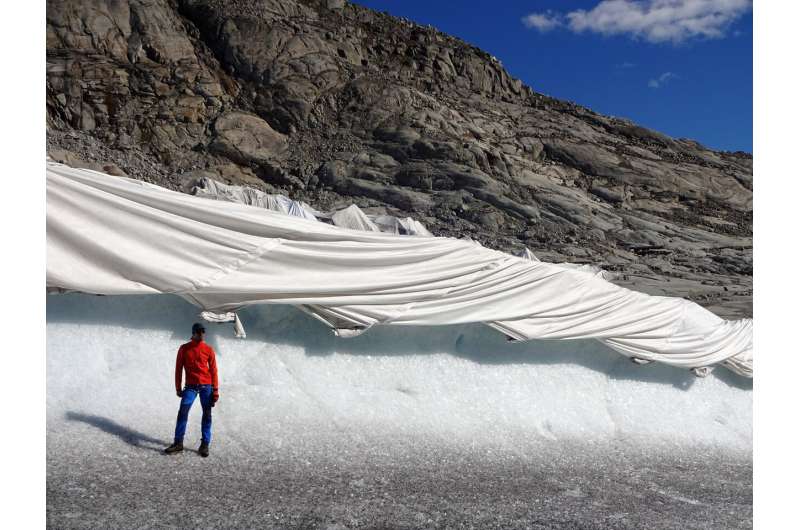A researcher stands in front of the Rhone Glacier covered in geotextiles that protect it from accelerated melting. Credit: Matthias Huss
In the Swiss Alps, some ski resorts and glacial tourist attractions are using reflective blankets known as geotextiles to protect parts of glaciers from accelerated summer melt caused by global warming. These businesses' stable winter incomes enable them to fund the use of expensive geotextiles during summers. If geotextiles are able to save small portions of glaciers in the Swiss Alps, could they be employed on entire glaciers on a global scale? A study published earlier this year argues that this strategy would inevitably fail.
Researchers at the University of Fribourg in Switzerland looked at nine different Swiss sites currently using geotextiles to reduce glacial melt, and analyzed the possibility of using geotextiles on a larger scale. While the data in the study showed that these fabrics were able to locally reduce glacial melt by 59%, it also revealed that this strategy is too expensive to protect the more than 450,000 square miles of glaciers around the world.
Geotextiles slow summer ice melt in a number of ways. The albedo of the white textiles, or the reflectivity of their surfaces, is about 50% higher than the albedo of glacial ice. When the sun's radiation hits the geotextiles, a large amount of the energy that would have melted the ice is radiated back into the atmosphere. The textiles also collect rain, the evaporation of which cools the glacier. In addition, they provide insulation that stabilizes the ice's cooler temperatures.
At first glance, this technological adaptation to global warming is a promising solution for those passionate about glacier preservation. However, like other technological climate change solutions, such as carbon capture and storage or floodwalls, using geotextiles on a large scale is expensive and potentially detrimental to surrounding ecosystems. As a result, they have only been applied on small scales, mostly in an effort to preserve profitable ski runs.
One of the Swiss glaciers in the study covered annually to protect it from melting. Credit: Matthias Huss
According to the study, covering glaciers in Switzerland annually costs between 0.60 and 8.50 U.S. dollars per square meter per year. At this rate, the cost of installation and maintenance of a square kilometer of geotextile coverage would range from $600 to $8,500. Using the average of this cost range, $4,550, the cost of covering the total area of Swiss glaciers (1,000 square kilometers) would be $4.5 billion dollars—a significant expense, even for the wealthiest country in the world. The total glacier area on Earth is roughly 250,000 square kilometers. Though the cost per unit area would vary greatly from region to region, a rough initial estimate, based on the cost for Switzerland, places the cost of covering all glaciers at a bit above $1 trillion per year.
Matthias Huss, a glaciologist at the University of Zurich and one of the authors of the study, told GlacierHub why this is not the solution some may hope it is. "You can put a blanket in one place on a glacier, let's say a few hundred square meters, and you can very efficiently protect ice locally. This absolutely works, but it costs a lot of money," he explained. "If you have a corresponding economic revenue from the glacier, then this works. Saving an entire glacier is a completely different story. You would need to cover all of the ice on a much larger scale without a clear income benefit."
Huss and his team of researchers concluded that attempting to prevent glacial melt with geotextiles cannot replace efforts to mitigate greenhouse gas emissions: finding ways to mitigate global warming must take precedence over inefficient and expensive technological solutions to small-scale effects of climate change.
Christian Huggel, a professor of glaciology at the University of Zurich, spoke with GlacierHub about the implications of this study. "The conclusions confirm what we have been saying for a while: such geotextiles may be a temporary solution for a very local problem of glacier loss but are not scalable. And most importantly, they are by no means a solution for the problem of glacier shrinkage," he said. "For this problem, the only solution is to reduce CO2 emissions as much as possible."
While this temporary and local solution does promise an extended life for some of Switzerland's most valued ski slopes, it does not offer a solution for the most dire problem facing the world's glaciers—the climate crisis.
More information: Matthias Huss et al. Quantifying the overall effect of artificial glacier melt reduction in Switzerland, 2005–2019, Cold Regions Science and Technology (2021). DOI: 10.1016/j.coldregions.2021.103237
Provided by Earth Institute at Columbia University
This story is republished courtesy of Earth Institute, Columbia University http://blogs.ei.columbia.edu.

























